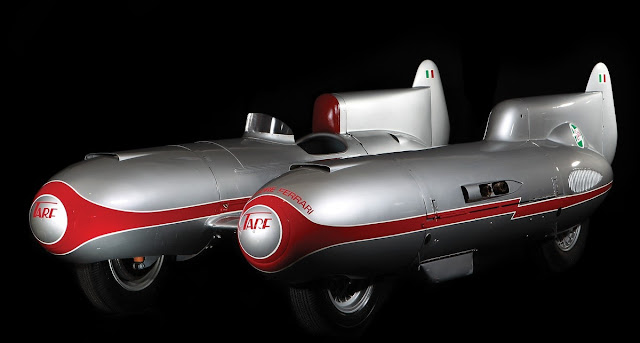"As a works driver for Mercedes-Benz, Ferrari, Maserati and Alfa Romeo, Piero Taruffi recorded a number of significant wins from 1930 to 1957, including the 1951 La Carrera Panamericana and the 1957 Mille Miglia, which is why many regard him as one of the great race drivers of his era. Yet he also used racing as a springboard for his many other achievements: He wrote a couple books about racing, he pursued a doctorate in industrial engineering, and he also designed his own record-breaking race cars, one of which will cross the block at RM’s Monaco auction next month.
In fact, the car in question, his Italcorsa/Tarf II bisiluro appears to have been the ultimate incarnation of Taruffi’s dream of reinventing the race car. Taruffi’s first attempt at a twin-boom car, the aluminum-bodied 1948 Italcorsa/Tarf I, which used a 50hp 500cc Guzzi V-twin engine mounted in the right-hand pod, set six 500cc records in November that year at speeds of up to 130 MPH. Its success led him to envision an even more radical race car – one with three booms – that he patented (U.S. Patent 2,608,264), claiming better aerodynamics and visibility than existing race cars.
While it appears he never built that “trisiluro,” over the next couple of years he did design a successor bisiluro that reversed driver and engine positions and used a 1,720cc Maserati four-cylinder engine with a dual-stage supercharger system that developed 290hp. The Tarf II, as it is now known, again transmitted power to the rear wheel via chain and used independently sprung wheels at all four corners along with adjustable tail fins to compensate for wind direction.
Its first outing, in March 1951, resulted in a pair of records: one for the flying mile at 185.49 MPH and one for the flying kilometer at 180.55 MPH. He would later set more records with it: in January 1952, averaging 144.00 MPH in the 50 mile; and in April 1952, averaging 140.87 MPH in the 50 kilometer, 139.66 MPH in the 100 kilometer, 136.60 MPH in the 200 kilometer, and 135.10 MPH in the one-hour.
Reportedly, he continued to set records in the Tarf II with different engines through 1957, when he retired from racing, but he also stated that he had planned a larger version – powered by a 4.5-liter Ferrari engine – to enter into the Indianapolis 500. “The importance of my car is that it embodies many new principles that will become standard in automobiles ten years from now,” he told Mechanix Illustrated for its January 1952 issue.
Despite the records and the publicity that Taruffi’s cars received, the bisiluro design never caught on with race car designers. Carlo Mollino most famously tried out the design on Nardi’s entry into the 1955 24 Hours of Le Mans, and in 1967 OSI built the Silver Fox concept car as a tribute to Taruffi, but neither was successful. Over here in the States, hot rodders occasionally built cars using the twin-boom design for dry lakes and Bonneville land-speed racing, most notably Howard Johansen’s car, which made the cover of Hot Rod‘s December 1949 issue.
According to RM’s auction description, Taruffi held on to the Tarf II for some time afterward, but by 1986 it had made its way to Australia, where it was fitted with the Ferrari Dino V-6 engine currently in it for demonstration runs at the Vintage Sports Car Club’s Speed Classic Event in Fremantle. It was even later recommissioned for racing and scheduled to run at the 2007 Lake Gardiner Speed Week."







